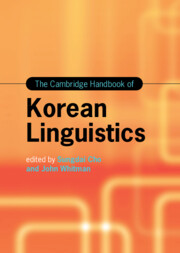Book contents
- The Cambridge Handbook of Korean Linguistics
- Cambridge Handbooks in Language and Linguistics
- The Cambridge Handbook of Korean Linguistics
- Copyright page
- Contents
- Figures
- Tables
- Contributors
- Preface
- Acknowledgments
- Abbreviations
- Part I Korean Overview
- Part II Phonetics and Phonology
- Part III Morphology and Syntax
- Part IV Semantics and Pragmatics
- Part V Sociolinguistics and Psycholinguistics
- Chapter 23 Grammaticalization in Korean
- Chapter 24 Performing Gender in Korean: Language, Gender, and Social Change
- Chapter 25 Jejueo: Korea’s Other Language
- Part VI Language Pedagogy
- Index
- References
Chapter 23 - Grammaticalization in Korean
from Part V - Sociolinguistics and Psycholinguistics
Published online by Cambridge University Press: 30 September 2022
- The Cambridge Handbook of Korean Linguistics
- Cambridge Handbooks in Language and Linguistics
- The Cambridge Handbook of Korean Linguistics
- Copyright page
- Contents
- Figures
- Tables
- Contributors
- Preface
- Acknowledgments
- Abbreviations
- Part I Korean Overview
- Part II Phonetics and Phonology
- Part III Morphology and Syntax
- Part IV Semantics and Pragmatics
- Part V Sociolinguistics and Psycholinguistics
- Chapter 23 Grammaticalization in Korean
- Chapter 24 Performing Gender in Korean: Language, Gender, and Social Change
- Chapter 25 Jejueo: Korea’s Other Language
- Part VI Language Pedagogy
- Index
- References
Summary
Chapter 23 reviews the role of grammaticalization at different levels of grammar: phonological, morpho-syntactic, paradigmatic, and semantic-pragmatic. It first discusses the dischronic principles and mechanisms that have been proposed in previous grammaticalization studies. The chapter then examines the prominent patterns by source category, dividing these into nouns and verbs. In the nominal category, four source construction types are illustrated with the reanalyses that led to their emergence as grammatical forms such as postpositions, conjunctions, and auxiliaries. In the verbal category, four source construction types are illustrated, with special focus on the grammaticalization of de-verbal postpositions and auxiliary verbs. The chapter further addresses select aspects of Korean grammaticalization from a typological perspective. It discusses the productive use of affixes, converbs, and predicatives known as “mermaid constructions”, which are among the characteristics shared by many languages in the eastern Eurasian region. It also discusses the presence of large inventories of de-verbal postpositions and numeral classifiers.
Keywords
- Type
- Chapter
- Information
- The Cambridge Handbook of Korean Linguistics , pp. 659 - 688Publisher: Cambridge University PressPrint publication year: 2022

